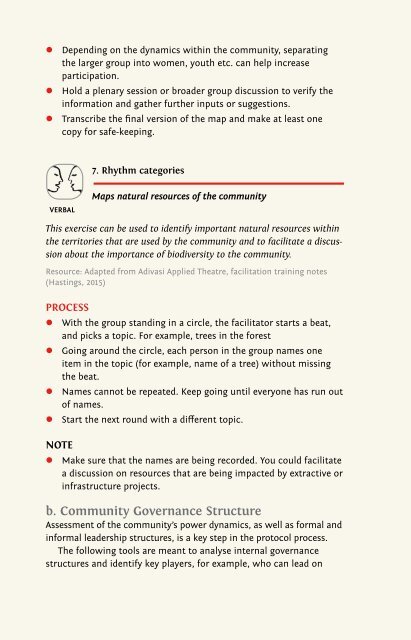COMMUNITY PROTOCOLS TOOLBOX
toolbox_complete
toolbox_complete
Create successful ePaper yourself
Turn your PDF publications into a flip-book with our unique Google optimized e-Paper software.
l Depending on the dynamics within the community, separating<br />
the larger group into women, youth etc. can help increase<br />
participation.<br />
l Hold a plenary session or broader group discussion to verify the<br />
information and gather further inputs or suggestions.<br />
l Transcribe the final version of the map and make at least one<br />
copy for safe-keeping.<br />
VERBAL<br />
7. Rhythm categories<br />
Maps natural resources of the community<br />
This exercise can be used to identify important natural resources within<br />
the territories that are used by the community and to facilitate a discussion<br />
about the importance of biodiversity to the community.<br />
Resource: Adapted from Adivasi Applied Theatre, facilitation training notes<br />
(Hastings, 2015)<br />
PROCESS<br />
l With the group standing in a circle, the facilitator starts a beat,<br />
and picks a topic. For example, trees in the forest<br />
l Going around the circle, each person in the group names one<br />
item in the topic (for example, name of a tree) without missing<br />
the beat.<br />
l Names cannot be repeated. Keep going until everyone has run out<br />
of names.<br />
l Start the next round with a different topic.<br />
NOTE<br />
l Make sure that the names are being recorded. You could facilitate<br />
a discussion on resources that are being impacted by extractive or<br />
infrastructure projects.<br />
b. Community Governance Structure<br />
Assessment of the community’s power dynamics, as well as formal and<br />
informal leadership structures, is a key step in the protocol process.<br />
The following tools are meant to analyse internal governance<br />
structures and identify key players, for example, who can lead on<br />
community protocol process, leaders whose consent may need to be<br />
sought, persons who have influence in local politics etc.<br />
VISUAL<br />
8. Identifying key actors<br />
Identifies key actors<br />
To identify actors who have influence over relevant issues, such as a particular<br />
mining project, a particular resource or the community’s overall<br />
ways of life.<br />
Resource: Adapted from Stakeholder Power Analysis (IIED, 2005), available at<br />
http://www.policy-powertools.org/Tools/Understanding/docs/stakeholder_<br />
power_tool_english.pdf.<br />
PROCESS<br />
Universities<br />
Environmental NGOs<br />
Global community<br />
Traditional<br />
authorities<br />
The labour movement<br />
Forest-edge<br />
communities<br />
Farmers<br />
Government<br />
forestry agencies<br />
Students<br />
Timber<br />
industry<br />
Journalists<br />
1 2 3<br />
Polical parties Churches<br />
l Prepare a large bull’s eye diagram (like the one shown above<br />
adapted from Kotey et al., 1998) with several concentric circles.<br />
l Seek agreement about the focus of the analysis, for example, a<br />
particular mining project or a particular resource.<br />
l Facilitate a discussion to identify key actors (companies, institutions,<br />
government ministries, groups, or individuals) that affect<br />
the mining project, the resource or area.<br />
l Rank them according to power or degree of influence. This can be<br />
done with numbers, icons, or different sizes of paper.<br />
l Label them on the diagram. The ring closest to the centre represents<br />
the most influence and the outermost ring represents the<br />
least influence.<br />
14 15


